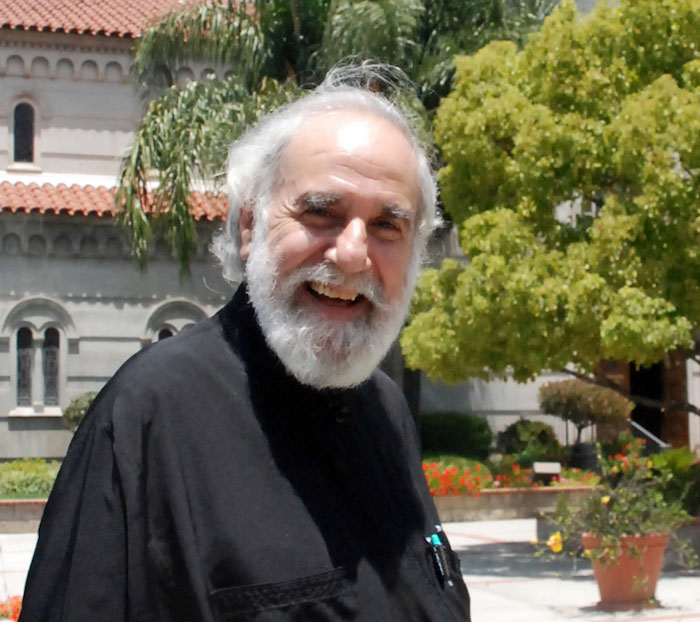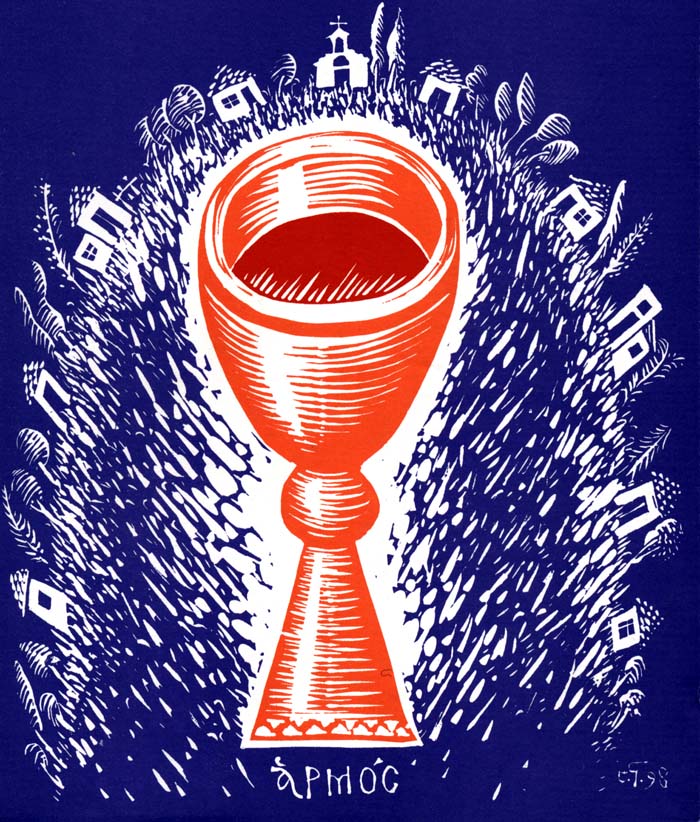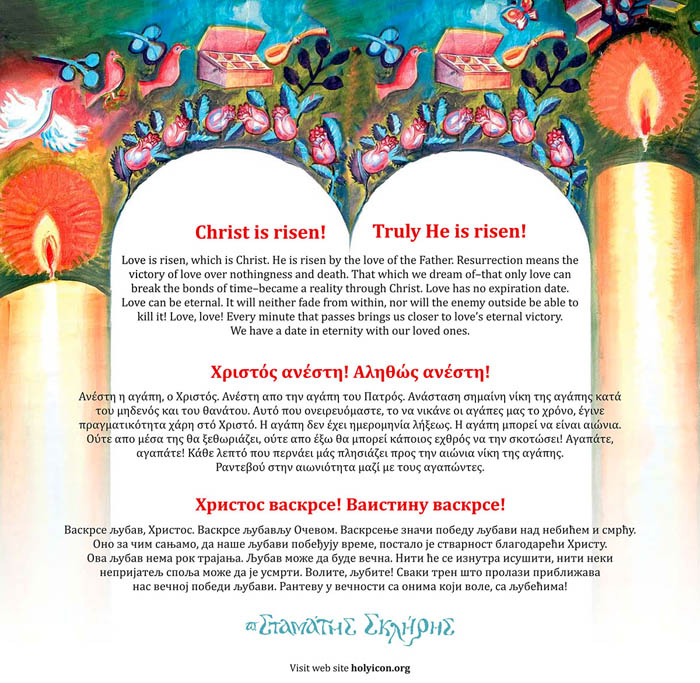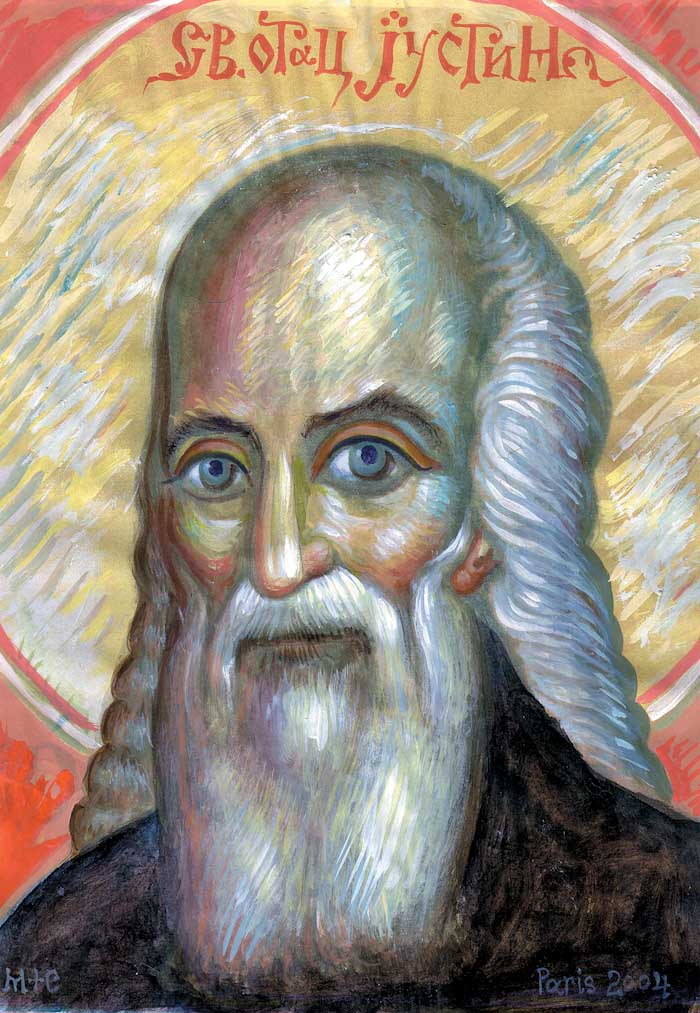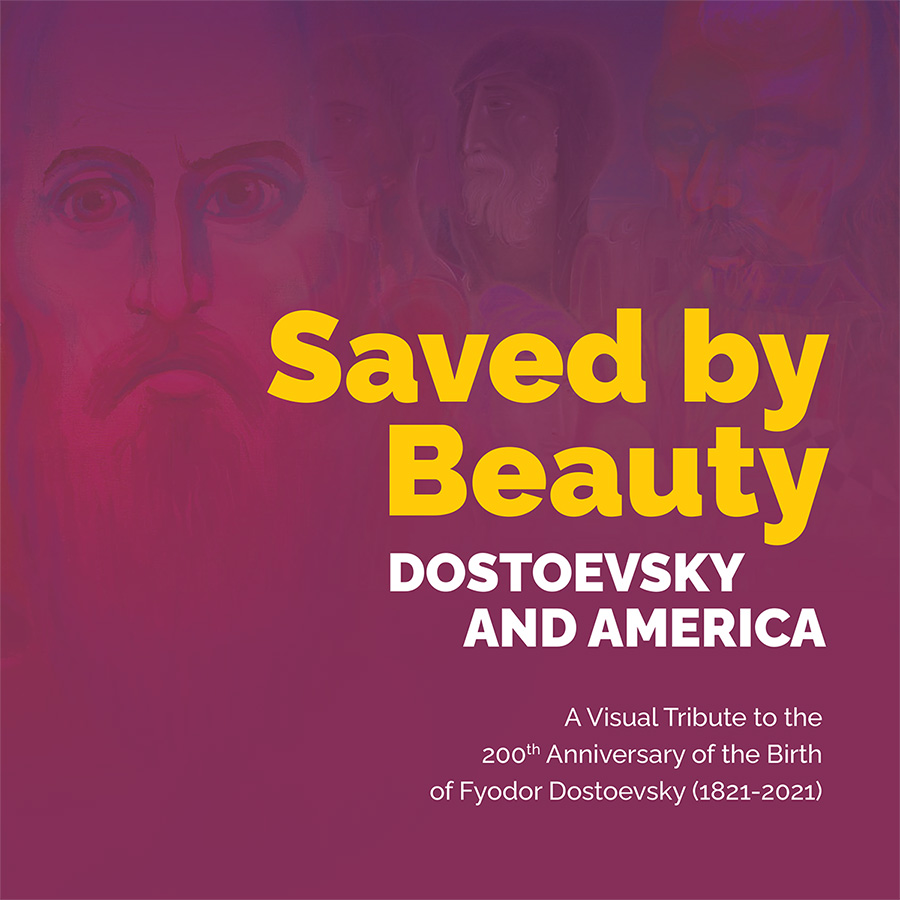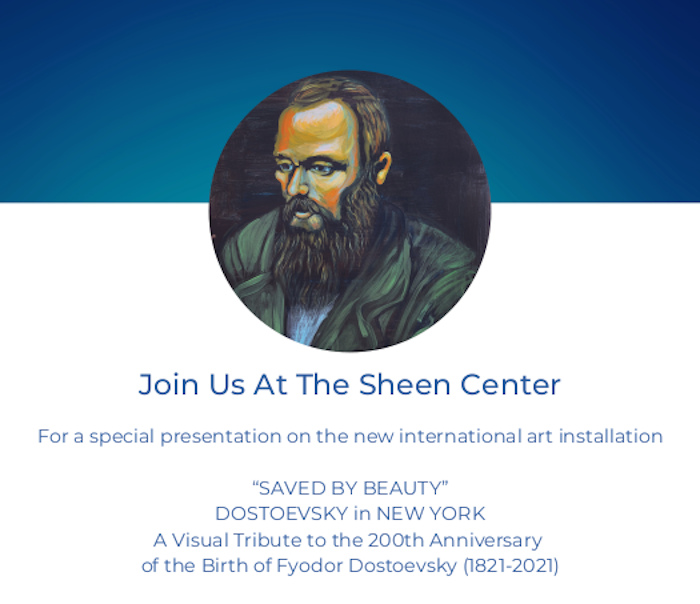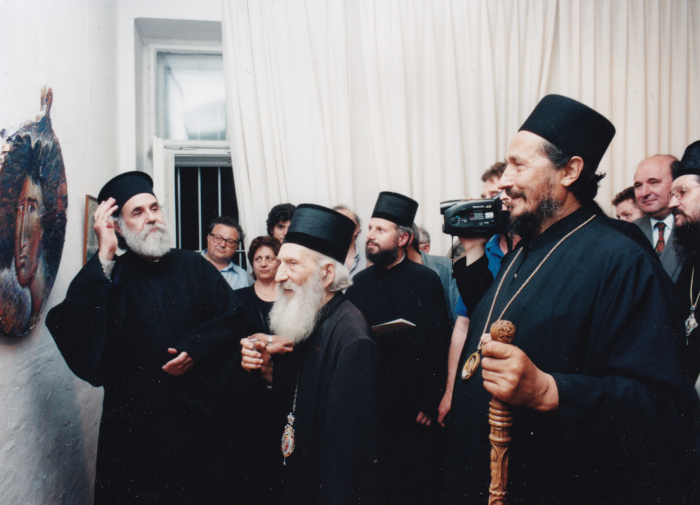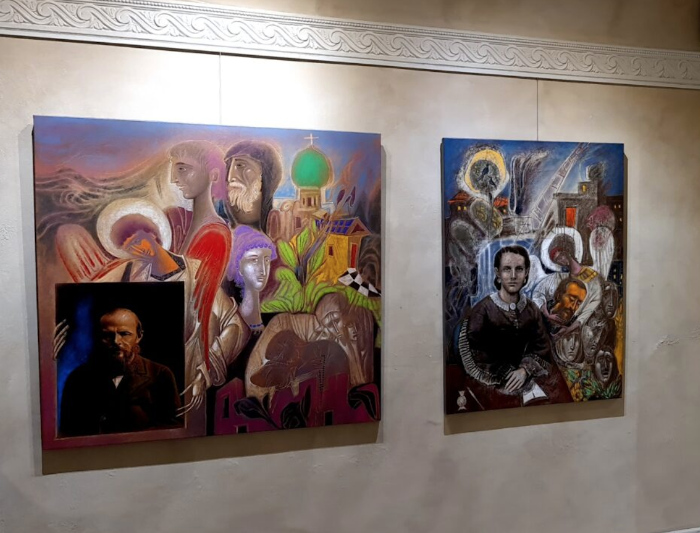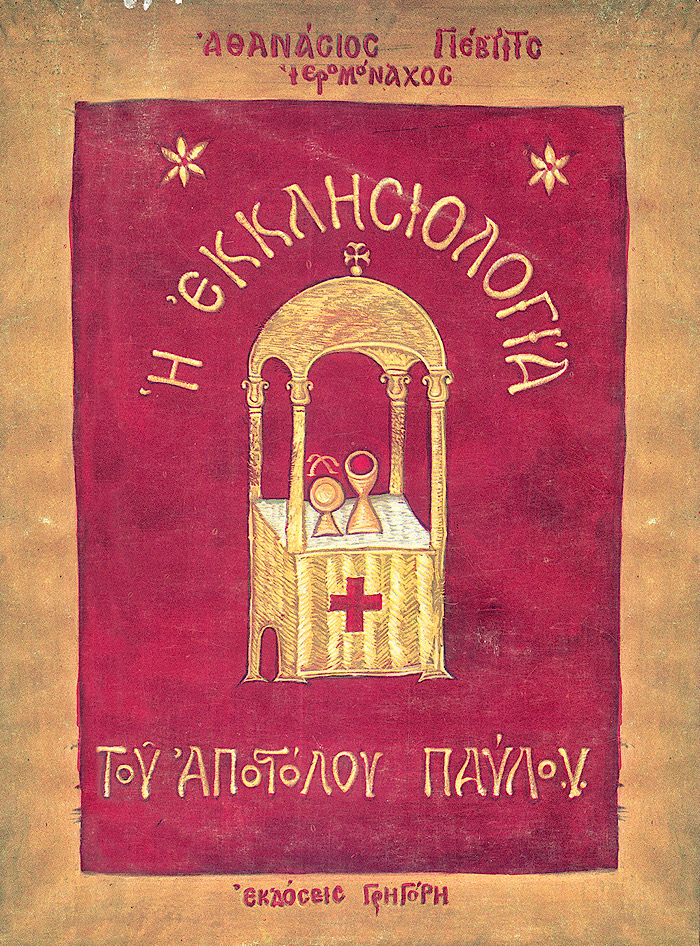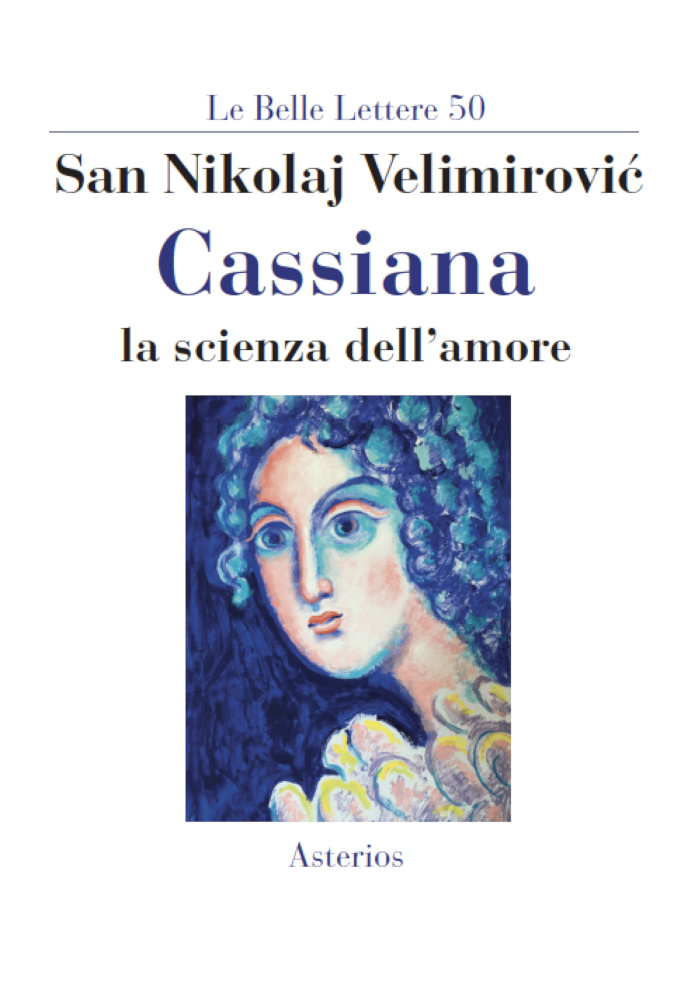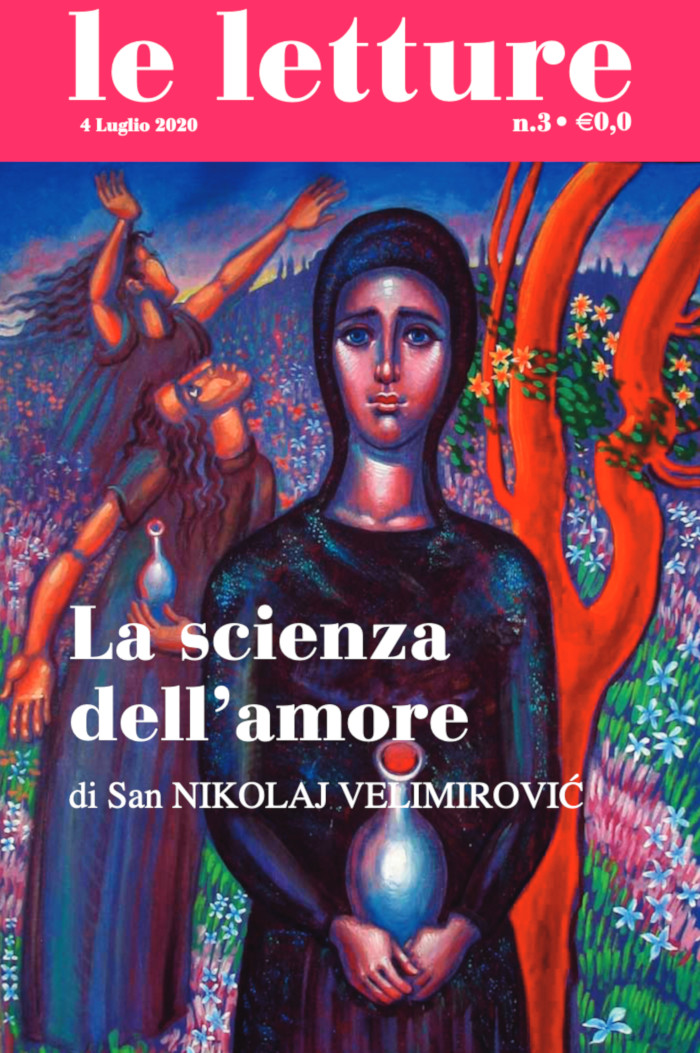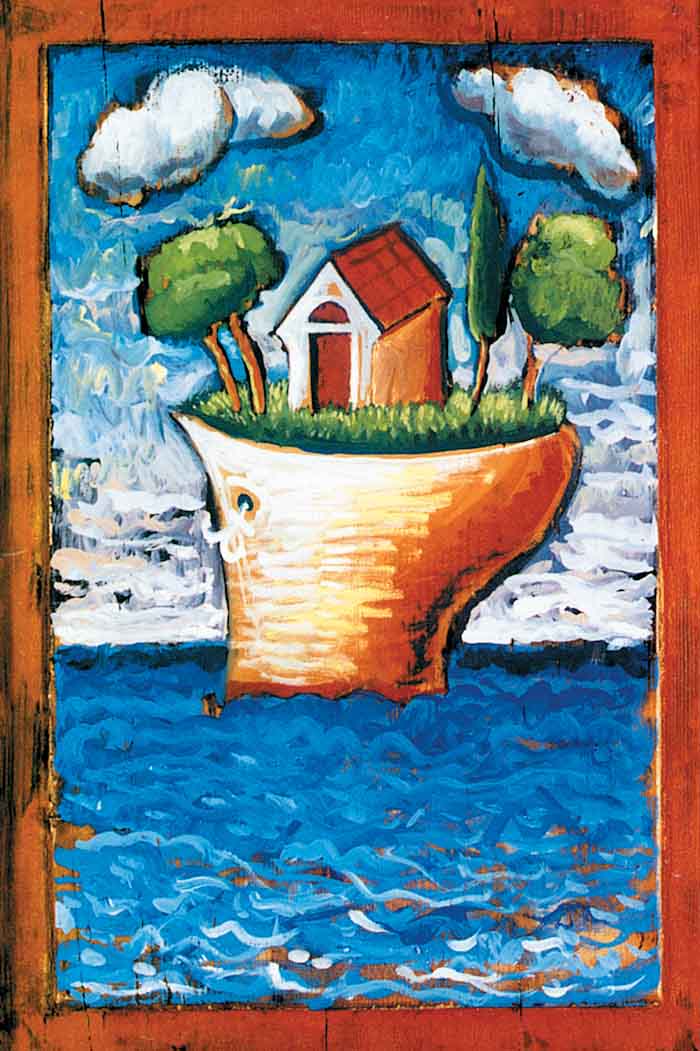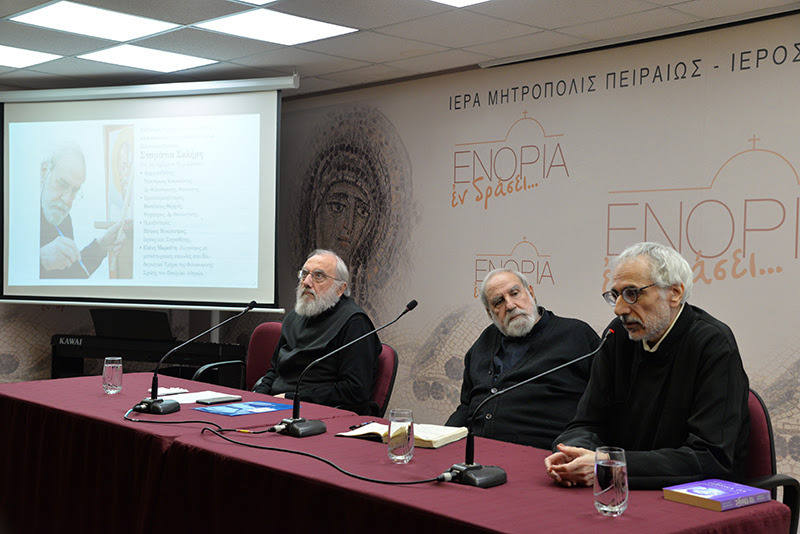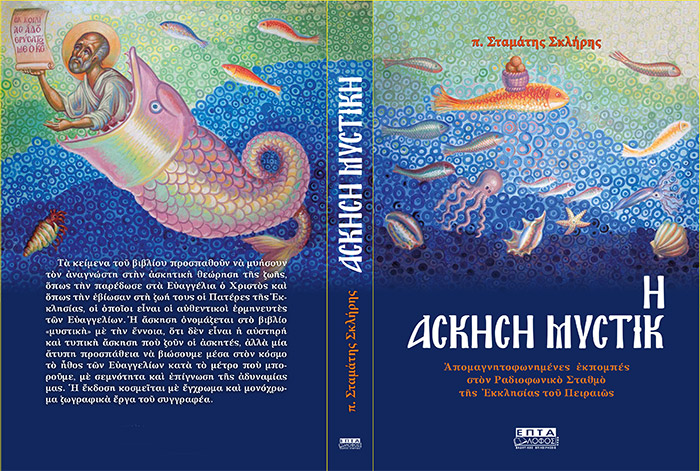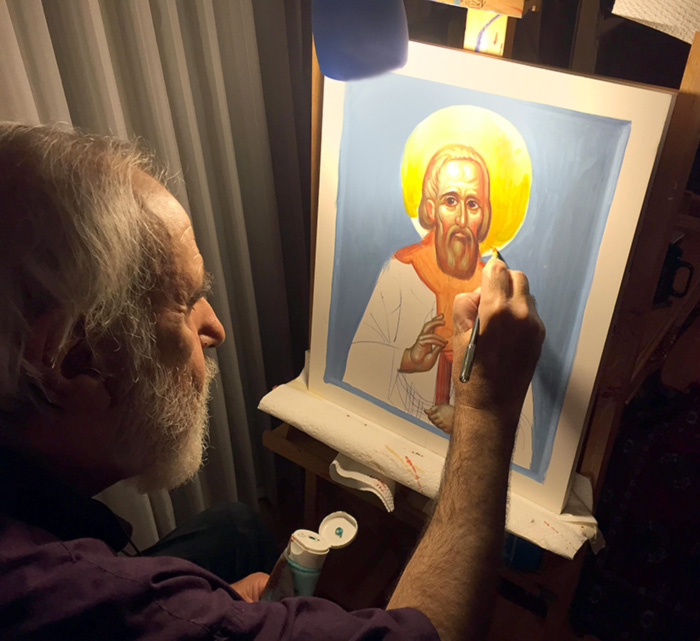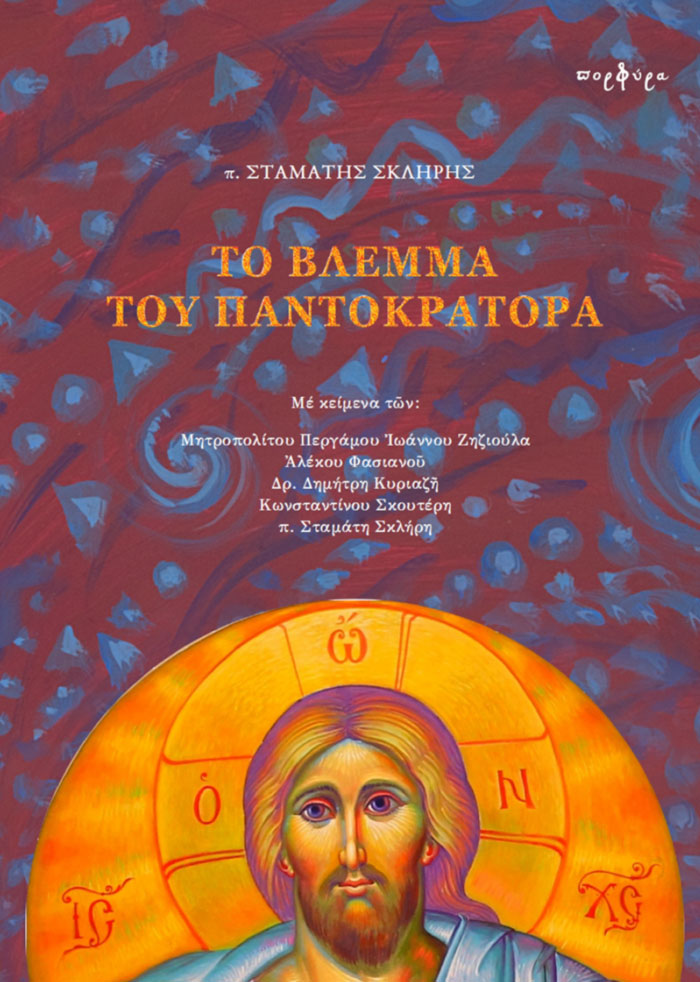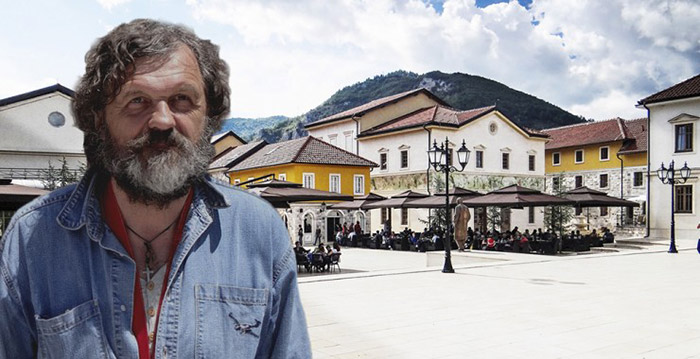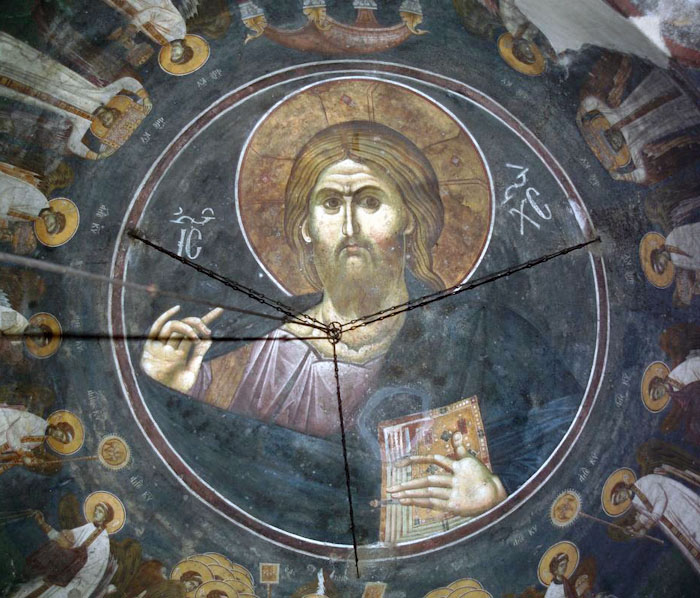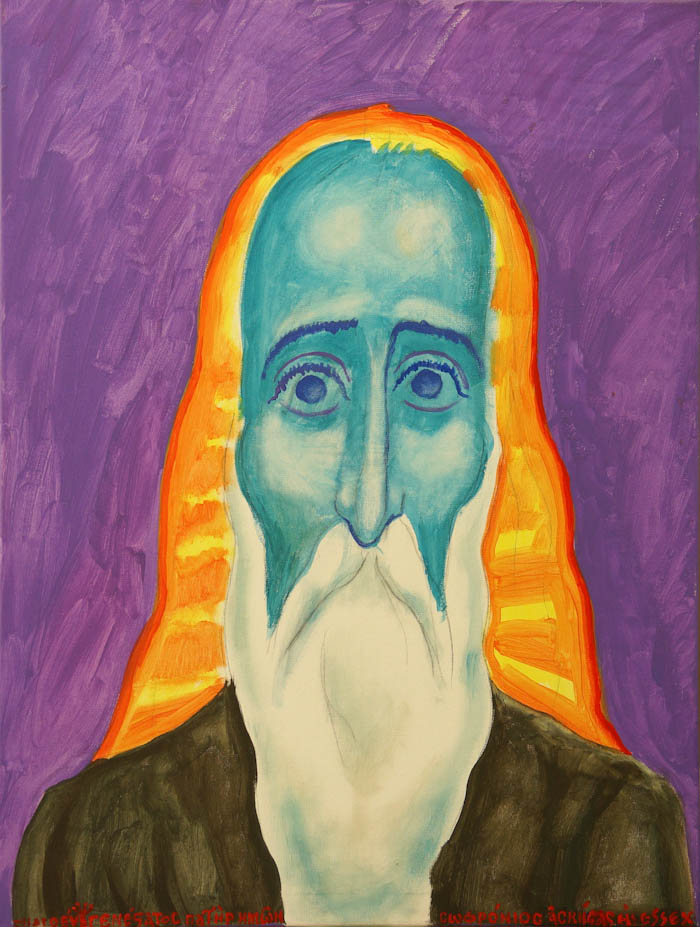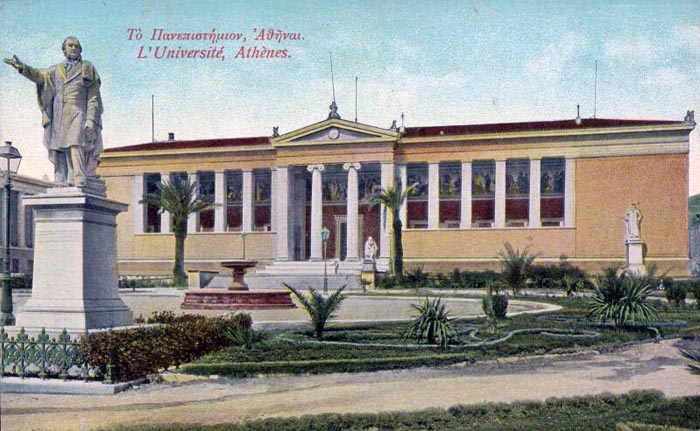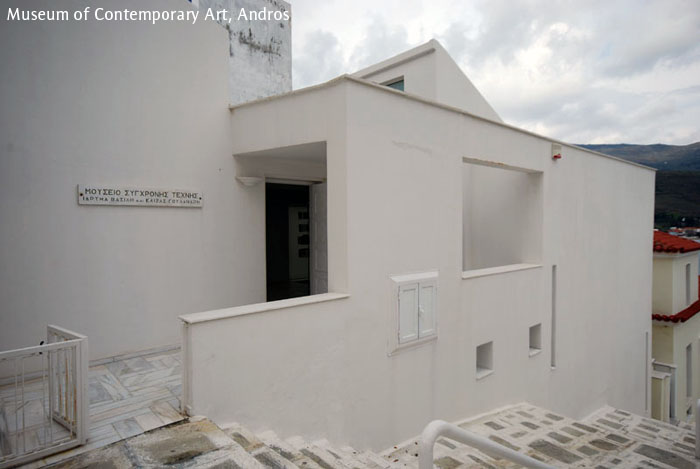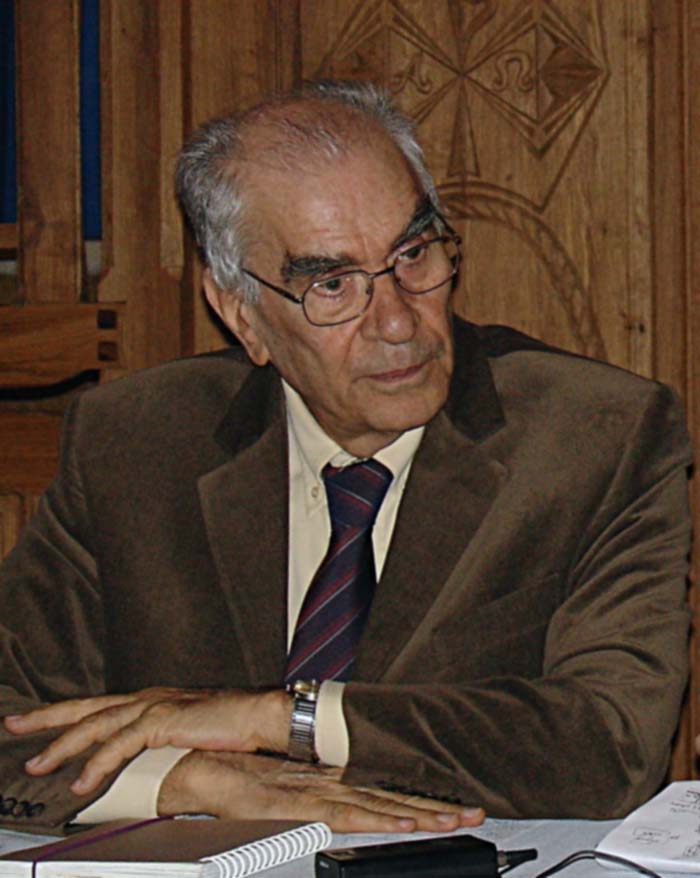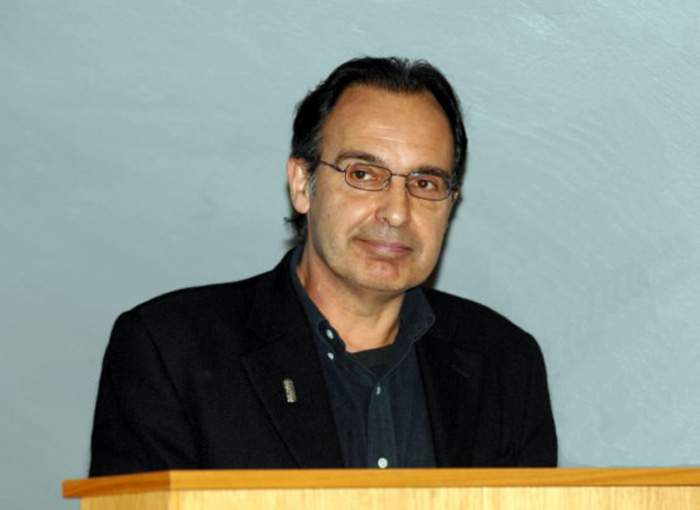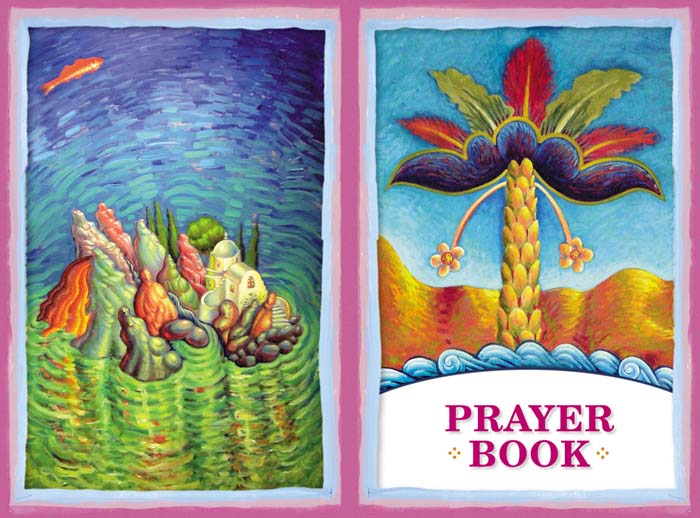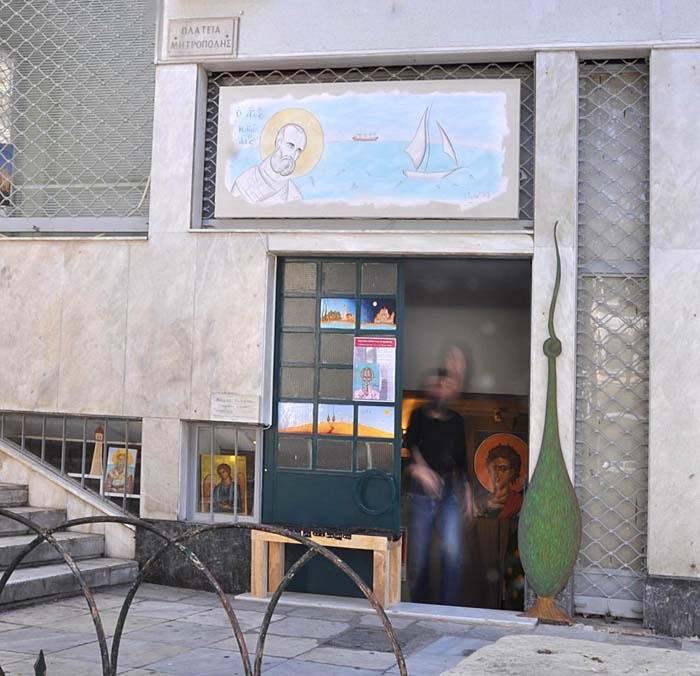Father Stamatis Skliris was born in Piraeus, the port of Athens, in 1946. At his baptism he was named after Holy New Martyr Stamatios from the island of Hydras. From the early childhood, he showed the artistic gifts and through his elementary and high school education, he began to paint and write church poems. Initially he completed the Medical faculty (1971), and then Theology (1976) at the University of Athens. He continues his studies in Belgrade at the Theological and Philosophical Faculty, attending lectures in Theology and Art History. His love and zeal for Theology and Art, defined him as one of the most knowledgeable Orthodox iconologos, iconographer and technotrope (designer and stylist) of icons, as well as of the ancient, medieval and modern art.
Along with his wife Marina he spent two years in Serbia, mostly in the Monastery of Cheliye, in the immediate vicinity of Fr. Justin (Popovic) – today St. Justin of Cheliye. During that period he decorated the monastery chapel devoted to St. Stefan the Decansky. He was initiated into the priesthood and since 1979. he has been serving in Athens.
Along with his wife Marina he spent two years in Serbia, mostly in the Monastery of Cheliye, in the immediate vicinity of Fr. Justin (Popovic) – today St. Justin of Cheliye. During that period he decorated the monastery chapel devoted to St. Stefan the Decansky. He was initiated into the priesthood and since 1979. he has been serving in Athens.
This website is the definitive reference for information about his life and work, bringing a splash of color to the largest collection of Stamatis Art in the world. With a click you can see a complete inventory of his works, read a short biography, learn how his art is made, check his calendar of upcoming events, view some recent commissions, or make a purchase.
"From a particular moment onwards our traditional art had touched upon my heart. I thought I had discovered a kind of a hidden, mystical beauty. I bathed in the light of the Byzantine icon regarding everything else as being secondary. However, I needed to find a way—after having lived out tradition internally—to express it in my own work in relation to the issues of our time. That is: I needed to act just as an ancient Hellene or a Byzantine would act if living in our times. I borrowed the bright colors and brilliant brush strokes from Impressionism and clothed them with the centripetal lighting of an Icon. It is thus, in my opinion, that emerged an art of painting similar to the Hellenistic, Greco-Roman, but, simultaneously, both Byzantine and modern. In other words, the East has moved closer to the West, and the so called secular art to that which is seen as sacred."
TO ALL VISITORS OF HOLY ICON WEBSITE FR STAMATIS WISHES
♡ ΚΑΛΟ ΚΑΛΟΚΑΙΡΙ ♡ HAPPY SUMMER ♡
♡ ΚΑΛΟ ΚΑΛΟΚΑΙΡΙ ♡ HAPPY SUMMER ♡
Christ is risen! Truly He is risen!
Love is risen, which is Christ. He is risen by the love of the Father. Resurrection means the victory of love over nothingness and death. That which we dream of—that only love can break the bonds of time—became a reality through Christ. Love has no expiration date. Love can be eternal. It will neither fade from within, nor will the enemy outside be able to kill it! Love, love! Every minute that passes brings us closer to love’s eternal victory. We have a date in eternity with our loved ones.
Love is risen, which is Christ. He is risen by the love of the Father. Resurrection means the victory of love over nothingness and death. That which we dream of—that only love can break the bonds of time—became a reality through Christ. Love has no expiration date. Love can be eternal. It will neither fade from within, nor will the enemy outside be able to kill it! Love, love! Every minute that passes brings us closer to love’s eternal victory. We have a date in eternity with our loved ones.
By Bishop Maxim (Vasiljević)
Stamatis Skliris’ contribution to modern art (both Church art, and art in general) through his painting and iconography is already a generally established fact. With this review we would like to sketch the historical context behind the appearance of Skliris the zographos (i.e. one who paints from life or from nature using fresh, natural colors) and, by making a theological-aesthetical analysis of his iconographic opus, to emphasize clearly and objectively some of the particular qualities of his art in relation to the iconography of the second half of the twentieth century.
Stamatis Skliris’ contribution to modern art (both Church art, and art in general) through his painting and iconography is already a generally established fact. With this review we would like to sketch the historical context behind the appearance of Skliris the zographos (i.e. one who paints from life or from nature using fresh, natural colors) and, by making a theological-aesthetical analysis of his iconographic opus, to emphasize clearly and objectively some of the particular qualities of his art in relation to the iconography of the second half of the twentieth century.
By Metropolitan of Pergamon John (Zizioulas)
Finally, the main characteristic of Fr. Stamatis’ paintings is the gaze. Although his work encompasses many forms of painting – frescos, icons, pictures, book illustrations, etc. – and although it employs various techniques and styles, there is something common to all of it that unites everything and that gives everything a stable identity. This characteristic is the gaze from the image. Inall the painted images by Fr. Stamatis, the gaze is “questioning.” As in the Psalms God “searches the hearts andreins” (Ps. 7:9), so also the gaze of these paintings questions and inquires about the existential depth of the picture’s observer.
Finally, the main characteristic of Fr. Stamatis’ paintings is the gaze. Although his work encompasses many forms of painting – frescos, icons, pictures, book illustrations, etc. – and although it employs various techniques and styles, there is something common to all of it that unites everything and that gives everything a stable identity. This characteristic is the gaze from the image. Inall the painted images by Fr. Stamatis, the gaze is “questioning.” As in the Psalms God “searches the hearts andreins” (Ps. 7:9), so also the gaze of these paintings questions and inquires about the existential depth of the picture’s observer.
A Collection of Iconographic Essays and Illustrations by Fr. Stamatis Skliris
The Serbian Orthodox Diocese of Western America is pleased to announce the publication of an outstanding book by Fr. Stamatis Skliris, a disciple of the great twentieth-century theologians Archimandrite Justin Popovich and Bishop Athanasius Yevtich. Fr. Stamatis is a parish priest in Athens and is renowned as an iconographer and as a writer and lecturer on Byzantine iconography.
The Serbian Orthodox Diocese of Western America is pleased to announce the publication of an outstanding book by Fr. Stamatis Skliris, a disciple of the great twentieth-century theologians Archimandrite Justin Popovich and Bishop Athanasius Yevtich. Fr. Stamatis is a parish priest in Athens and is renowned as an iconographer and as a writer and lecturer on Byzantine iconography.
Within an Athenian church, Father Stamatis Skleris anchors a celestial passage, baptizing Avgerinos and Stergiani's child in waters reflecting heaven's threshold. The infant's innocent form shifts realms beneath the surface, his cries a primal hymn to the sanctity enveloping him. Surrounding souls partake in this divine blessing, a community woven into the child's nascent tapestry of existence. Here, in a mystery transcending time, a delicate miracle unfolds, heralding a journey anew in the sacred echoes of ancestral faith.
Fr. Stamatis Skliris
When we are on the bus and we arrive at the bus station, we see genuine faces and glances. Nevertheless, cinema and fashion have instructed people to be pretentious and to adopt a fake manner of standing, speaking, and moving. This constitutes an alienation of the human person. As an artist, I strive to discover the real humanity. We have even lost the scent of carnation. The sellers of carnation say that the scent is gone, even though the form remains the same. It is carnation in the form, but it is not full since it has no particular scent. As an iconographer, I have to depict a saint. The saint is a man who stands before God and before his fellow man with love. He is in a state of confession. Me too; I am in a state of confession at this moment. I am trying to express what is my problem. As the ancient philosopher Diogenes said, “I am searching for a man.” Indeed, we are searching nowadays for a man who does not seek one’s self-interest, who is not cunning and devious. We are accustomed to playing roles; honesty is thus tricky. One way would be to depose the masks we are searching for and find the true “me.” And if I find the true me, I can see the true “you”.
When we are on the bus and we arrive at the bus station, we see genuine faces and glances. Nevertheless, cinema and fashion have instructed people to be pretentious and to adopt a fake manner of standing, speaking, and moving. This constitutes an alienation of the human person. As an artist, I strive to discover the real humanity. We have even lost the scent of carnation. The sellers of carnation say that the scent is gone, even though the form remains the same. It is carnation in the form, but it is not full since it has no particular scent. As an iconographer, I have to depict a saint. The saint is a man who stands before God and before his fellow man with love. He is in a state of confession. Me too; I am in a state of confession at this moment. I am trying to express what is my problem. As the ancient philosopher Diogenes said, “I am searching for a man.” Indeed, we are searching nowadays for a man who does not seek one’s self-interest, who is not cunning and devious. We are accustomed to playing roles; honesty is thus tricky. One way would be to depose the masks we are searching for and find the true “me.” And if I find the true me, I can see the true “you”.
A Visual Tribute to the 200th Anniversary of the Birth of Fyodor Dostoevsky (1821-2021)
Download PDF CATALOG
The bicentenary celebration of the birth of the great Russian author Fyodor Dostoevsky (1821-2021), considered one of the most outstanding writers of modern literature, has found the world in an increasing state of bewilderment. Some believe that the dynamic and open anthropology of this classic can help rectify an issue because it has the power to break the defensive armor of the modern ego and take us beyond its ideological constraints.
Download PDF CATALOG
The bicentenary celebration of the birth of the great Russian author Fyodor Dostoevsky (1821-2021), considered one of the most outstanding writers of modern literature, has found the world in an increasing state of bewilderment. Some believe that the dynamic and open anthropology of this classic can help rectify an issue because it has the power to break the defensive armor of the modern ego and take us beyond its ideological constraints.
March 18 – April 30, 2022
Gallery Exhibition | Free Admission
Gallery Hours: Monday – Friday 11:00 a.m. to 7:00 p.m. | Saturdays 12:00 p.m. – 7:00 p.m.
“Man can live without science, he can live without bread, but without beauty he could no longer live.” -- Fyodor Dostoevsky (from the novel Demons)
Gallery Exhibition | Free Admission
Gallery Hours: Monday – Friday 11:00 a.m. to 7:00 p.m. | Saturdays 12:00 p.m. – 7:00 p.m.
“Man can live without science, he can live without bread, but without beauty he could no longer live.” -- Fyodor Dostoevsky (from the novel Demons)
Exhibition of Fr Stamatis’ paintings in Trebinje, 1998, on the occasion of celebration of 800 years of Hilandar Monastery
"THE DREAM OF A RIDICULOUS MAN"
A Visual Tribute to the 200th Anniversary of the Birth of Fyodor Dostoevsky (1821-2021)
Visit PHOTO GALLERY FROM THE EXHIBITION
Painting exhibition of the group “OCHRE” in the METS Art Gallery, 6 Eugeniou Voulgareos in METS, Athens, September 17, 2021.
"OCHRE" is an informal group of painters, who have contributed to the traditional Orthodox iconography but at the same time are in dialogue with the modern artistic trends. The exhibition is organized with great passion by the 16 artists and has exceeded all expectations.
A Visual Tribute to the 200th Anniversary of the Birth of Fyodor Dostoevsky (1821-2021)
Visit PHOTO GALLERY FROM THE EXHIBITION
Painting exhibition of the group “OCHRE” in the METS Art Gallery, 6 Eugeniou Voulgareos in METS, Athens, September 17, 2021.
"OCHRE" is an informal group of painters, who have contributed to the traditional Orthodox iconography but at the same time are in dialogue with the modern artistic trends. The exhibition is organized with great passion by the 16 artists and has exceeded all expectations.
Εικαστικό αφιέρωμα στα 200 χρόνια από την γέννηση του Φιόντορ Ντοστογίεβσκυ. Στο κέντρο τεχνών ΜΕΤΣ (ευγενίου Βουλγάρεως 6, Μετσ). Εγκαίνια 17 Σεπτεμβρίου 2021 (7μμ-10μμ). Διάρκεια μέχρι 15 Οκτωβρίου.
Συμμετέχουν οι εξής καλλιτέχνες: Επίσκοπος Μάξιμος Βασίλιεβιτς, π. Σταμάτης Σκλήρης, Μπάμπης Πυλαρινός, Κώστας Λάβδας, Μαρία Πάνου, Γιαννούλης Λυμπερόπουλος, Νεκτάριος Μαμάης, Φώτης Βάρθης, Κωνσταντίνος Κουγιουμτζής, Χρήστος Κεχαγιόγλου, Νεκτάριος Σταματέλος, Γκόρντανα Ραντόγιεβιτς, Δέσποινα Καραντάνη, Γιώργος Μαργαρίτης, Χριστίνα Παπαθέου – Δουληγέρη, Γιώργος Κόρδης.
Η αίθουσα τέχνης είναι ανοικτή Τρίτη, Πέμπτη, Παρασκευή απόγευμα (6μμ-9μμ) και Σάβατο πρωί (11πμ- 2μμ). Θα χαρούμε να συναντηθούμε εκεί και να χαρούμε όλοι μαζί τους εικαστικούς διαλόγους των συμμετεχόντων σύγχρονων έλλήνων δημιουργών με το πρόσωπο και το έργο του μεγάλου ρώσου δημιουργού.
Source: kordis.gr
Συμμετέχουν οι εξής καλλιτέχνες: Επίσκοπος Μάξιμος Βασίλιεβιτς, π. Σταμάτης Σκλήρης, Μπάμπης Πυλαρινός, Κώστας Λάβδας, Μαρία Πάνου, Γιαννούλης Λυμπερόπουλος, Νεκτάριος Μαμάης, Φώτης Βάρθης, Κωνσταντίνος Κουγιουμτζής, Χρήστος Κεχαγιόγλου, Νεκτάριος Σταματέλος, Γκόρντανα Ραντόγιεβιτς, Δέσποινα Καραντάνη, Γιώργος Μαργαρίτης, Χριστίνα Παπαθέου – Δουληγέρη, Γιώργος Κόρδης.
Η αίθουσα τέχνης είναι ανοικτή Τρίτη, Πέμπτη, Παρασκευή απόγευμα (6μμ-9μμ) και Σάβατο πρωί (11πμ- 2μμ). Θα χαρούμε να συναντηθούμε εκεί και να χαρούμε όλοι μαζί τους εικαστικούς διαλόγους των συμμετεχόντων σύγχρονων έλλήνων δημιουργών με το πρόσωπο και το έργο του μεγάλου ρώσου δημιουργού.
Source: kordis.gr
ΗΜΕΡΟΛΟΓΙΟ 2021
Από τις εκδόσεις Ακρίτα κυκλοφορεί το επιτοίχιο Ημερολόγιο της Ενορίας του Αγίου Νικολάου Ραγκαβά στην Πλάκα για το 2021.
«Οι Άγγελοι μας χαιρετούν» με 13 αδημοσίευτα έργα του Αγιογράφου και Θεολόγου, π. Σταμάτη Σκλήρη.
Από τις εκδόσεις Ακρίτα κυκλοφορεί το επιτοίχιο Ημερολόγιο της Ενορίας του Αγίου Νικολάου Ραγκαβά στην Πλάκα για το 2021.
«Οι Άγγελοι μας χαιρετούν» με 13 αδημοσίευτα έργα του Αγιογράφου και Θεολόγου, π. Σταμάτη Σκλήρη.
Bookcover for "Ἡ Ἐκκλησιολογία τοῦ Ἀποστόλου Παύλου κατὰ τὸν ἱερὸν Χρυσόστομο" by Hieromonk Athanasios Yevtich, acrylic on cardborad, 1984.
La scienza dell'amore
Autore: San Nikolaj Velimirović
A cura di: Antonio Ranzolin
Traduzione di: Antonio Ranzolin
Autore: San Nikolaj Velimirović
A cura di: Antonio Ranzolin
Traduzione di: Antonio Ranzolin
Autore: San Nikolaj Velimirović
Traduzione di: Antonio Ranzolin
Traduzione di: Antonio Ranzolin
By Bishop Ignatije (Midić)
Church art, and thereby art of painting, cannot be independent from the Church and its own truth. It is expressing, or it is attempting to express, the truth of the Church. But, when we talk of the truth of the Church, as is the case with the truth of other beings and types of communion, we come to the conclusion that the truth is not so easily perceptible for everything and to all; especially so because the truth is mixed with something which is not the truth, but which is the destiny of every being in existence in history, and thus also of the Church itself. What is the truth of the Church?
Church art, and thereby art of painting, cannot be independent from the Church and its own truth. It is expressing, or it is attempting to express, the truth of the Church. But, when we talk of the truth of the Church, as is the case with the truth of other beings and types of communion, we come to the conclusion that the truth is not so easily perceptible for everything and to all; especially so because the truth is mixed with something which is not the truth, but which is the destiny of every being in existence in history, and thus also of the Church itself. What is the truth of the Church?
Αποτελεί έναν γνήσιο άνθρωπο του Χριστού, της αγάπης εν ελευθερία. Λαχταράει την βασιλεία του Θεού και αυτό φαίνεται και από την ζωγραφική του, με τα λαμπερά χρώματα, όπου όλα είναι λουσμένα από το φως της αγάπης του Θεού.
Του Σταμάτη Μιχαλακόπουλου
Εκδήλωση τιμής και ευγνωμοσύνης στον Θεολόγο, Αγιογράφο και Ιατρό Πρωτοπρεσβύτερο Σταμάτιο Σκλήρη, πραγματοποιήθηκε την Κυριακή 8 Δεκεμβρίου, στο Πνευματικό Κέντρο του Ιερού Ναού Ευαγγελιστρίας Πειραιώς, στο πλαίσιο του προγράμματος «ΕΝΟΡΙΑ εν δράσει…».
Του Σταμάτη Μιχαλακόπουλου
Εκδήλωση τιμής και ευγνωμοσύνης στον Θεολόγο, Αγιογράφο και Ιατρό Πρωτοπρεσβύτερο Σταμάτιο Σκλήρη, πραγματοποιήθηκε την Κυριακή 8 Δεκεμβρίου, στο Πνευματικό Κέντρο του Ιερού Ναού Ευαγγελιστρίας Πειραιώς, στο πλαίσιο του προγράμματος «ΕΝΟΡΙΑ εν δράσει…».
Τα κείμενα του βιβλίου προσπαθούν να μυήσουν τον αναγνώστη στην ασκnτική θεώρησn τηs ζωης, όπωs την παρέδωσε στα Εύαγγέλια ο Χριστόs καί όπωs την έβίωσαν στη ζωή τουs οι Πατέρεs της Εκκλnσίαs, οι όποιοι είναι οί αυθεντικοί ερμηνευτέs των Ευαγγελίων.
Ο πνευματικός μου πατέρας είναι ο Γκρέκο είχε πει ο Σεζάν. Ο πατέρας μου είναι ο Σεζάν και ο παππούς μου ο Γκρέκο, είχε πει ο Πικάσο.
Born on June 21, 1863 in San Francisco, Sebastian Dabovich, now Saint Sebastian, was the first Orthodox Christian priest born in the United States. Born in San Francisco, California in 1863, the son of one of the earliest known Serbian immigrants to the United States, he was well known for his missionary-apostolic work establishing Orthodox Christian parishes all along the West Coast, including the first distinctly Serbian Orthodox parish in Jackson, California in 1892. The church building there, still home to an active parish, is an officially designated National Historical Landmark. Fr. Sebastian produced inspiring homilies in English, Serbian and Russian, as well as several books in English for missionary needs.
The Gaze of the Pantocrator
- Details
- Published: 17 July 2015
This is a unique portfolio of hitherto unpublished works by Father Stamatis Skliris, based around the theme of man’s perception of the divine, sacred, blessed face of this world and the world beyond. It immerses us in the ineffable depths of Byzantine art, as this has survived over the centuries of man’s attempt to depict the sacred, and as it has evolved in our day, mediated through the attentive vision of Father Stamatis Skliris, priest, doctor and icon-painter.
Разговор оца Стаматиса Склириса и Емира Кустурице
Разговор је вођен на Црквини у Требињу, крајем јуна 2014.
Разговор је вођен на Црквини у Требињу, крајем јуна 2014.
By Fr. Stamatis Skliris
From time immemorial, through the sprawling labyrinths of time, over the misty highlands of earth, across the vast expanses of space, through grandiose reflections of things past and future—likely and unlikely outcomes, murky speculations, cavernous fantasies, and foggy uncertainties of what exists, existed, will exist, or did not exist, or what is decreasing or increasing, or what is being conceived, or what is latently inconceivable—all races, all genders, all human societies, and every person individually who has wanted to be unique, who has wanted to be god, every single one of them has contributed to painting a portrait of God.
From time immemorial, through the sprawling labyrinths of time, over the misty highlands of earth, across the vast expanses of space, through grandiose reflections of things past and future—likely and unlikely outcomes, murky speculations, cavernous fantasies, and foggy uncertainties of what exists, existed, will exist, or did not exist, or what is decreasing or increasing, or what is being conceived, or what is latently inconceivable—all races, all genders, all human societies, and every person individually who has wanted to be unique, who has wanted to be god, every single one of them has contributed to painting a portrait of God.
Père Stamatis Skliris
Cézanne disait que El Greco était son père en la peinture. Picasso disait que Cézanne était son père et El Greco son grand-père. Si Cézanne était le fondateur et Picasso le principal représentant du modernisme, nous pouvons supposer que El Greco a introduit quelque chose de nouveau dans l'art de la Renaissance qui a finalement conduit à l'art moderne. Nous présumons que ceci a un rapport avec les racines byzantines de Greco qui,dans sa jeunesse, peignait des icônes byzantinessur son île natale de Crète. Cet élément, qu’on considère nouveau et subversif pour la Renaissance, existait bien avant dans la peinture byzantine.
Cézanne disait que El Greco était son père en la peinture. Picasso disait que Cézanne était son père et El Greco son grand-père. Si Cézanne était le fondateur et Picasso le principal représentant du modernisme, nous pouvons supposer que El Greco a introduit quelque chose de nouveau dans l'art de la Renaissance qui a finalement conduit à l'art moderne. Nous présumons que ceci a un rapport avec les racines byzantines de Greco qui,dans sa jeunesse, peignait des icônes byzantinessur son île natale de Crète. Cet élément, qu’on considère nouveau et subversif pour la Renaissance, existait bien avant dans la peinture byzantine.
Saint Kallisti
I often borrow elements from different artistic periods in the service of the icons I paint. This icon of St. Kallisti was ordered by someone in the Crimea. It was painted on Saturday 7 June 2014. Some people may not like it, but it may just be an authentic portrait.
I often borrow elements from different artistic periods in the service of the icons I paint. This icon of St. Kallisti was ordered by someone in the Crimea. It was painted on Saturday 7 June 2014. Some people may not like it, but it may just be an authentic portrait.
By Fr. Stamatis Skliris
You could say that nowadays our faces are copies of one another, and that all of us are copies of the general models of fabricated [false] life. A perfect example are the stars of Los Angeles. Similarly, the faces painted by contemporary iconographers are poor models (falsely referred to as "Byzantine") of an insipid, monotonous, and repellant repetition. These images portray an army of false saints, rather than unique and unrepeatable persons.
You could say that nowadays our faces are copies of one another, and that all of us are copies of the general models of fabricated [false] life. A perfect example are the stars of Los Angeles. Similarly, the faces painted by contemporary iconographers are poor models (falsely referred to as "Byzantine") of an insipid, monotonous, and repellant repetition. These images portray an army of false saints, rather than unique and unrepeatable persons.
By Fr. Stamatis Skliris
Seek sensitivity everywhere, so that you may stumble upon it both in life and in nature. In your painting, do not adhere strictly to the existing art movements. Don't be preoccupied with the main subject you are trying to paint, nor with the artistic values, as they are called by aestheticians and art critics. Or, to put it better, solve your art issues as if they were humanity issues, visually transposed to sensitivity issues. This is to say, when two or three thin lines impose themselves, articulating the fine expression of lines and shadows, it is a way for the human spirit to materialize in human likeness. The same applies in the imposition of a certain sensitivity expressed by colours. Here again, we can see that the man is a being "not of this world".
Seek sensitivity everywhere, so that you may stumble upon it both in life and in nature. In your painting, do not adhere strictly to the existing art movements. Don't be preoccupied with the main subject you are trying to paint, nor with the artistic values, as they are called by aestheticians and art critics. Or, to put it better, solve your art issues as if they were humanity issues, visually transposed to sensitivity issues. This is to say, when two or three thin lines impose themselves, articulating the fine expression of lines and shadows, it is a way for the human spirit to materialize in human likeness. The same applies in the imposition of a certain sensitivity expressed by colours. Here again, we can see that the man is a being "not of this world".
André Tzourakis, Journaliste
Quotidien «I Kathimerini», Dimanche 15 décembre 1991
... L'observateur attentif percevra que ces icônes-portraits, ces dessins, ces gravures et ces compositions libres du père Stamatis sont comme les tentatives fragmentaires qui pourraient enfanter un résultat esthétique, révolutionnaire, en ce qui concerne une grande partie de notre héritage traditionnel.
Quotidien «I Kathimerini», Dimanche 15 décembre 1991
... L'observateur attentif percevra que ces icônes-portraits, ces dessins, ces gravures et ces compositions libres du père Stamatis sont comme les tentatives fragmentaires qui pourraient enfanter un résultat esthétique, révolutionnaire, en ce qui concerne une grande partie de notre héritage traditionnel.
Nikos Zias, Professor at the Faculty of Philosophy of the University of Athens
Man is the chief subject of paintings by Father Stamatis Skliris—man in his two aspects: redeemed and deified through grace, bathed in divine light, and at the same time confined by his own isolation and his quests.
Man is the chief subject of paintings by Father Stamatis Skliris—man in his two aspects: redeemed and deified through grace, bathed in divine light, and at the same time confined by his own isolation and his quests.
Kyriakos Koutsomallis, Director of the Museum of Contemporary Art in the island of Andros, Basil and Elise Goulandris Foundation.
It was a pleasure to receive Father Stamatis Skliris’ invitation to visit him at his studio in Paris. Conversation with him is an intellectual stimulus. His figurative language is on a level with his cogent dialectic. It is dynamic and carefully structured, and it makes no secret of the kind of relationship he wishes to suggest by the natural world he represents in his painting.
It was a pleasure to receive Father Stamatis Skliris’ invitation to visit him at his studio in Paris. Conversation with him is an intellectual stimulus. His figurative language is on a level with his cogent dialectic. It is dynamic and carefully structured, and it makes no secret of the kind of relationship he wishes to suggest by the natural world he represents in his painting.
Les recherches du père Stamatis Skliris
Christos Yannaras, Professeur de Philosophie à l'Université Panteios d'Athènes
Les recherches du père Stamatis Skliris ont transformé – transmué sans le diviser – le médecin en théologien, le théologien en prêtre, le prêtre en iconographe et l’iconographe en peintre. Des bonds de rapide maturation qui visent des choix essentiels. Rien n'est laissé au hasard et le tout compose une naïveté unique, pleine de grâce d’exigences enfantines. Ce qui domine toujours dans son itinéraire, c’est une approche tangible des recherches essentielles: le corps humain, le pain et le vin de l'Eucharistie, et ces «remontées vers le prototype», qui procèdent par les couleurs et mènent de la peinture iconographique vers la chair picturale de notre époque.
Christos Yannaras, Professeur de Philosophie à l'Université Panteios d'Athènes
Les recherches du père Stamatis Skliris ont transformé – transmué sans le diviser – le médecin en théologien, le théologien en prêtre, le prêtre en iconographe et l’iconographe en peintre. Des bonds de rapide maturation qui visent des choix essentiels. Rien n'est laissé au hasard et le tout compose une naïveté unique, pleine de grâce d’exigences enfantines. Ce qui domine toujours dans son itinéraire, c’est une approche tangible des recherches essentielles: le corps humain, le pain et le vin de l'Eucharistie, et ces «remontées vers le prototype», qui procèdent par les couleurs et mènent de la peinture iconographique vers la chair picturale de notre époque.
Τα αμερικάνικα τοπία του Παπασταμάτη
Το δράμα της εποχής είναι πως η διαφήμιση, η κατανάλωση και η κουλτούρα μπορούν να ταυτίζονται.
Παναγιώτης Κονδύλης, φιλόσοφος (1943-1998)
Στην εποχή που οι εικόνες κατακυριεύουν τα πράγματα επειδή η ορατότητα κατάντησε δυνάστης και που υπάρχει μόνο ό, τι φαίνεται, η ζωγραφική ζητεί εκ νέου να εκπληρώσει την παλιά της αποστολή: Να μεσιτεύσει δια του ορατού στο αόρατο και να ξαναδιεκδικήσει τη ψυχή των πραγμάτων κατοχυρώνοντας όμως πάνω απ’ όλα το σώμα τους.
Το δράμα της εποχής είναι πως η διαφήμιση, η κατανάλωση και η κουλτούρα μπορούν να ταυτίζονται.
Παναγιώτης Κονδύλης, φιλόσοφος (1943-1998)
Στην εποχή που οι εικόνες κατακυριεύουν τα πράγματα επειδή η ορατότητα κατάντησε δυνάστης και που υπάρχει μόνο ό, τι φαίνεται, η ζωγραφική ζητεί εκ νέου να εκπληρώσει την παλιά της αποστολή: Να μεσιτεύσει δια του ορατού στο αόρατο και να ξαναδιεκδικήσει τη ψυχή των πραγμάτων κατοχυρώνοντας όμως πάνω απ’ όλα το σώμα τους.
Kosta Bradich, academic painter
It is without a doubt a problem to speak, to write, to use words in order to explain that which is being iconised by fine art. If this should at all be possible, then the art of painting would not be necessary. However, I shall try to present my impressions regarding images on Fr Stamatis’ icons and frescoes.
It is without a doubt a problem to speak, to write, to use words in order to explain that which is being iconised by fine art. If this should at all be possible, then the art of painting would not be necessary. However, I shall try to present my impressions regarding images on Fr Stamatis’ icons and frescoes.
Inspired by the painting of the National Parks of America
Fr Stamatis Skliris
We walk on the very crust of the earth. Beneath us, a seething hot sun is hidden in a damp fiery form. Landscape painting is the portrayal of this crust, since the painter's main concern is the rendering of three-dimensional space on a two-dimensional canvas. This burning sun wears its lava as a dried up skin that swallows up the flames.
Fr Stamatis Skliris
We walk on the very crust of the earth. Beneath us, a seething hot sun is hidden in a damp fiery form. Landscape painting is the portrayal of this crust, since the painter's main concern is the rendering of three-dimensional space on a two-dimensional canvas. This burning sun wears its lava as a dried up skin that swallows up the flames.
Performed by Fr Stamatis Skliris
California, 2013
Portrays and places of American landscapes arranged through Orthodox Iconography in an unprecedented way, blending the Byzantine tradition with influences of contemporary arts, paintings and images, creating exciting canvases that transport the viewer to new realms of delight and inspiration.
California, 2013
Portrays and places of American landscapes arranged through Orthodox Iconography in an unprecedented way, blending the Byzantine tradition with influences of contemporary arts, paintings and images, creating exciting canvases that transport the viewer to new realms of delight and inspiration.
π. Σταμάτης Σκλήρης
To να δημιουργήσεις μιαν εικόνα είναι ταυτόχρονα και καλλιτεχνική δημιουργία και Θεολογική δημιουργία. Ο αγιογράφος επομένως πρέπει να αγωνίζεται, ζώντας μέσα στην Εκκλησiα την όλη εκκλησιαστική ζωή, να αναδεικνύεται με τη χάρη του Οεού ευαγγελιστής του πληρώματος της Εκκλησίας. Ταυτόχρονα ως προς το καλλιτεχνικό μέρος πρέπει να αγωνίζεται σαν μέλος της Εκκλησίας να ελαχιστοποιεί τις καλλιτεχνικές εμπάθειες. Κάποια πάθη δηλαδή, τα οποία για έναν καλλιτέχνη κοσμικό μπορεί να Θεωρούνται νορμάλ, ενώ για τον αγιογράφο αποβαίνουν επικίνδυνα. Δiότι φαλκιδεύουν την πνευματική πλευρά της εικόνας.
To να δημιουργήσεις μιαν εικόνα είναι ταυτόχρονα και καλλιτεχνική δημιουργία και Θεολογική δημιουργία. Ο αγιογράφος επομένως πρέπει να αγωνίζεται, ζώντας μέσα στην Εκκλησiα την όλη εκκλησιαστική ζωή, να αναδεικνύεται με τη χάρη του Οεού ευαγγελιστής του πληρώματος της Εκκλησίας. Ταυτόχρονα ως προς το καλλιτεχνικό μέρος πρέπει να αγωνίζεται σαν μέλος της Εκκλησίας να ελαχιστοποιεί τις καλλιτεχνικές εμπάθειες. Κάποια πάθη δηλαδή, τα οποία για έναν καλλιτέχνη κοσμικό μπορεί να Θεωρούνται νορμάλ, ενώ για τον αγιογράφο αποβαίνουν επικίνδυνα. Δiότι φαλκιδεύουν την πνευματική πλευρά της εικόνας.
St. Gregory Palamas and the Essence of Hesychasm
The following is translated from a talk given by His Grace, Atanasije (Jevtić), Retired Bishop of Zahumlje and Herzegovina (Serbian Orthodox Church), at the Sretensky Seminary in Moscow on November 1, 2001.
The following is translated from a talk given by His Grace, Atanasije (Jevtić), Retired Bishop of Zahumlje and Herzegovina (Serbian Orthodox Church), at the Sretensky Seminary in Moscow on November 1, 2001.
The Serbian Orthodox Diocese of Western America is pleased to announce the publication of a beautiful pocket-size, full-color, English-language Prayer Book, which has been compiled and designed by our newly enthroned His Grace, Bishop Maxim, and printed in Serbia. The book contains prayers commonly used by Orthodox Christians, lists of Scriptural Commandments, and brief articles on the precepts of Faith, proper conduct in church, and the meaning and practice of prayer. It is adorned with striking icons and illustrations by Fr. Stamatis Skliris, a parish priest in Athens who is renowned as an iconographer and as a writer and lecturer on Byzantine iconography.
Atelier Pilarinos, Athens, Mitropoleos Square 11, behind the sanctuary of the Athens Cathedral
Оn Wednesday, January 16, 2013, at 8:30 pm, there will be a presentation with slide-shows from the iconographic work of Father Stamatis Skliris. The author himself will comment on his works in varios churches in Greece and Serbia (among others: Saint Nektarios Voula, Prophet Elijah Castella, Evangelistria - Halandri, Agios Panteleimon, Glyfada, St George - Stemnitsa, Saint Maximus Kostolac, Serbia).
Оn Wednesday, January 16, 2013, at 8:30 pm, there will be a presentation with slide-shows from the iconographic work of Father Stamatis Skliris. The author himself will comment on his works in varios churches in Greece and Serbia (among others: Saint Nektarios Voula, Prophet Elijah Castella, Evangelistria - Halandri, Agios Panteleimon, Glyfada, St George - Stemnitsa, Saint Maximus Kostolac, Serbia).
In these well-timed conversations, led by Fr. Radovan Bigovic, many issues were brought up so that a contemporary reader could deepen and expand his or her understanding of the role of art in the life of the Church today, both Eastern and Western. So here we find answers to questions on the crisis of contemporary ecclesiastical art in West and East; for possibilities of having an impact of Impressionism, Expressionism, Cubism, Surrealism and Abstract painting on contemporary ecclesiastical painting; on the main distinction between secular painting and icon painting.
